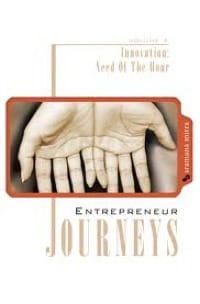New Book Review: "Entrepreneur Journeys v.4"
New book review for Entrepreneur Journeys v.4: Innovation - Need of the Hour (Volume 4), by Sramana Mitra, CreateSpace, 2010:


A sidebar interview with the author in a recent issue of "IEEE Spectrum" magazine made me aware of this "Entrepreneur Journeys" series of books. Although Mitra does write introductions to each of the sections of this book, other than the comments she shares as part of her questioning, the bulk of what she provides to readers are the interviews themselves. In this respect, this collection of interviews reminds me of "Coders at Work: Reflections on the Craft of Programming" (see my review), by Peter Seibel, although the interview direction here is not as weighty, and is concentrated at the business level, although technology is discussed to some extent because of the nature of the products with which the interviewee entrepreneurs have been associated.
Mitra groups the 13 interviews in this series entry into 4 loose categories: "Legendary Innovators", "Innovators in Academia", "Cross-Domain Innovators", and "Shoestring Innovators". The reason I use the term "loose" is because the interviewees can feasibly be categorized in a multitude of ways, and the interviewer decided to concentrate on innovation. The author notes in her prologue that "In this volume, I offer a multitude of lenses through which entrepreneurs can look at innovation in its various forms and decide on the right course of action for themselves. And as before, I have included a discussion on bootstrapping and shoestring innovation, which still remains one of the most practical ways to circumvent the early-stage fund crunch while maintaining control and freedom."
What the author provides here are really case studies in entrepreneurship, and while she presents a wide variety of technology business scenarios to which not all readers will be able to connect directly, the discussions provide substantive material to ponder and apply to their own journeys. For example, Judy Estrin, who co-founded Bridge Communications, remarks that "We were very passionate about this idea of interconnecting networks. However, we were not so passionate and so fixated that we were unwilling to realize that the interconnect business opportunity would take longer to develop and that it was too far ahead of its time."
Paul Cook, who co-founded Raychem, remarks that "The main principles I believe in, in terms of succeeding in business, are as follows: First, pick a technology niche that you can lead in, that others haven't done before, and that you can master. Then develop products based on that technology to enable high prices relative to cost, yielding a good gross profit. This will allow you to continue to spend on additional product development as well as investing in sales and marketing necessary for new innovations." And later, "You have to have a market pull. There has to be a market out there that wants your product."
Founder of FireEye, Ashar Aziz, comments that "For an entrepreneur, it's tricky to balance timing. You can be too early and the market is not there, or too late when there are too many competitors. There is a strike window, but it's not obvious where that strike window is. It's like landing a fighter jet on an aircraft carrier, the landing strip is very tiny and moving all over the place. Here is my very generic advice for entrepreneurship, which you can apply to any domain. Generally, an entrepreneur is looking for opportunities. The question to ask is why are incumbents not taking advantage of the opportunity? If there is food at the table, why are the bigger guys not eating it?"
Athenahealth founder Jonathan Bush mentions that "We've been hard at work bringing about the death of the old-fashioned software companies that dominate healthcare IT. Their business models and companies should be dead – they've been doing a great job of falling apart. Now, thanks to the federal government, they'll be given another five years to live, which will slow us down and prevent the evolution of software-enabled service business models. Eventually, they're going to die because at a fundamental level they do the wrong thing. This is a long-term lesson about how important it is for marketplaces to disrupt themselves. But overall it won't hurt us. In fact, it has brought a lot of attention, energy, debate, and focus. That may allow the best model to win yet."
As a consultant, I especially enjoyed the "Open Source Means Business" group of interviews within the "Shoestring Innovators" section of this book. CollabNet founder Brian Behlendorf comments that "I had never worked for a big company, so I always assumed the software engineering management had all the development problems sorted out – that it was just us cheapskates in the open-source world who were making do with simple tools. In reality, corporations had no tools to enable engineering teams to work across geographic boundaries with insight into other team's efforts." And John Roberts, founder of SugarCRM, remarks that "This notion of building proprietary software that was a complete secret, followed by massive high-end sales forces selling it door to door didn't make sense when in reality only a dime per dollar was used on the product."